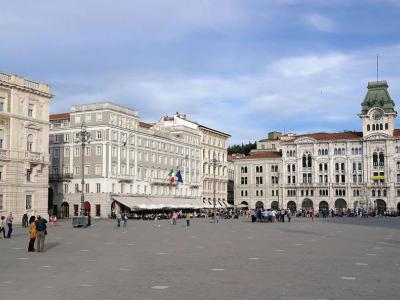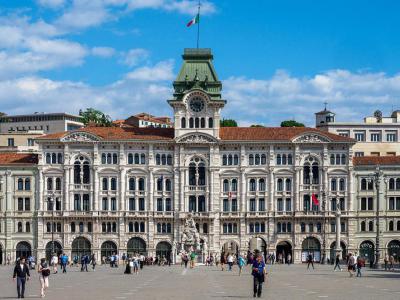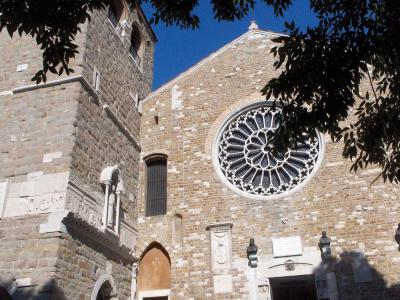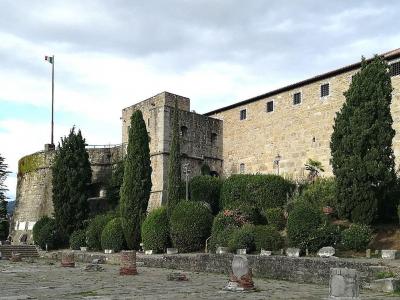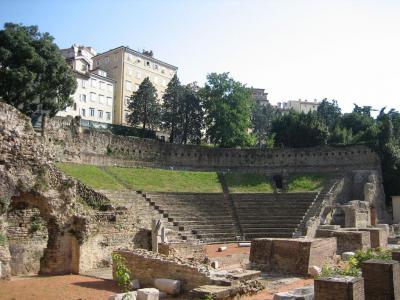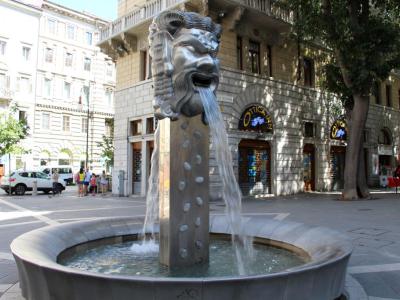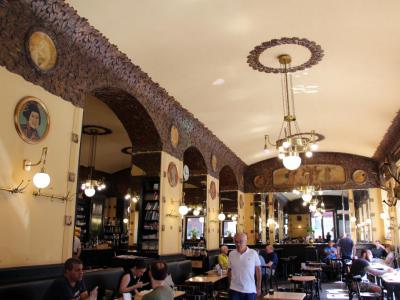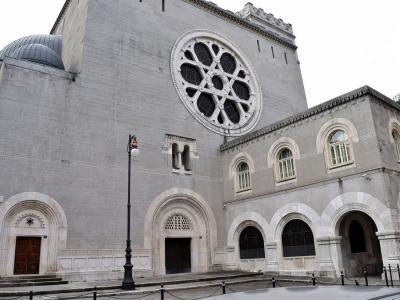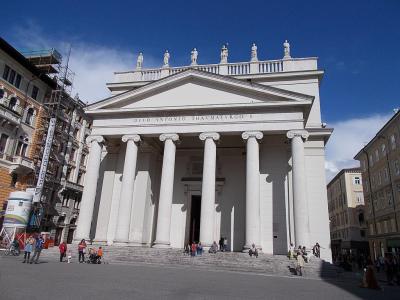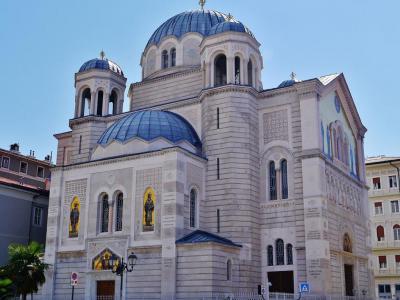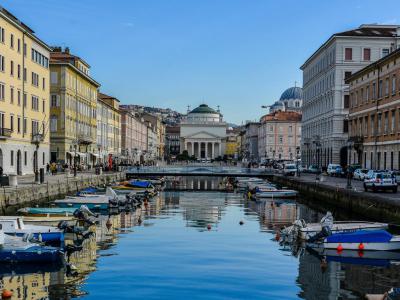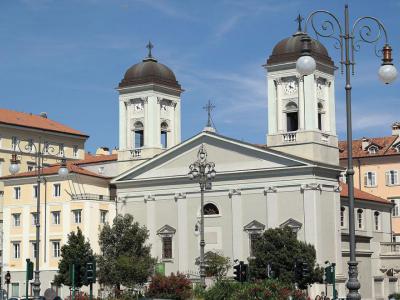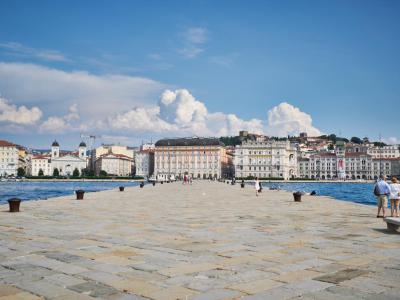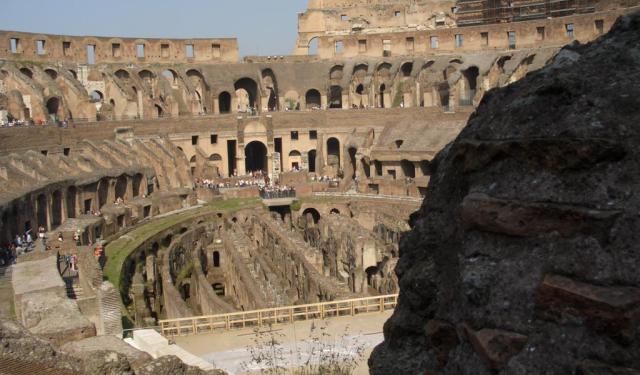Audio Guide: Trieste Introduction Walking Tour (Self Guided), Trieste
Let’s drop into Trieste, a city that’s always had one foot in Central Europe and the other dipping into the Adriatic. It sits at Italy’s northeastern edge, pressed against Slovenia, where winds tear across the Karst Plateau and caves open like gateways underground. Some call it “Vienna by the Sea,” others swear it’s the “City of Coffee,” but labels never really fit. From the start, this was a place where worlds converged. Even its name-Tergeste in Latin, tied to “terg”, the Venetic word for “market”-tells you commerce was at its core. The Romans knew its value: Emperor Augustus threw up walls, Emperor Trajan ordered a theatre, and the wealthy built villas in the Barcola district to catch sea breezes and dodge those notorious winds.
Centuries rolled, and Trieste kept changing identities. Rome, then Byzantines, then Franks; all left their trace. By the Middle Ages, Venice wanted to pull it into its orbit, but Trieste took a gamble on the Habsburgs instead. That decision stuck for centuries, defining the city’s pulse. As Austria’s main port, Trieste flourished-ships carried Central Europe’s goods out into the Mediterranean, while money and ideas flowed in. The 18th and 19th centuries brought a cultural boom: neoclassical faces, baroque facades, Viennese order, and coffee houses where writers plotted their next pages. Italians, Austrians, Slovenians, Croats, Jews, Greeks-whole communities lived together, weaving a collaboration that still shows in the city’s languages, food, and faiths.
Then the 20th century crashed in. The Austro-Hungarian Empire collapsed, and Trieste was annexed to Italy in 1918, commemorated in the vast Unity of Italy Square opening onto the sea. The city’s fortunes, though, stayed unsettled. Occupied by Nazi Germany during the Second World War, split by Italian-Yugoslav disputes in the postwar years, it only found some stability in 1954, when it was returned permanently to Italy. A frontier city in every sense-caught in disputes, but always a bridge rather than a wall.
Walk it today, and you’ll feel those layers stack. Climb the hill to the Castle and Cathedral of Saint Giusto, where medieval stones and sacred relics turn back the time. Cross back down to the waterfront, where Habsburg palaces still lean against the sea. Or linger in a café and get inspired by the poetic ambience. At first glance, Trieste might look indecisive. Geographically, culturally and architecturally at the border, but it offers a little bit of everything.
Centuries rolled, and Trieste kept changing identities. Rome, then Byzantines, then Franks; all left their trace. By the Middle Ages, Venice wanted to pull it into its orbit, but Trieste took a gamble on the Habsburgs instead. That decision stuck for centuries, defining the city’s pulse. As Austria’s main port, Trieste flourished-ships carried Central Europe’s goods out into the Mediterranean, while money and ideas flowed in. The 18th and 19th centuries brought a cultural boom: neoclassical faces, baroque facades, Viennese order, and coffee houses where writers plotted their next pages. Italians, Austrians, Slovenians, Croats, Jews, Greeks-whole communities lived together, weaving a collaboration that still shows in the city’s languages, food, and faiths.
Then the 20th century crashed in. The Austro-Hungarian Empire collapsed, and Trieste was annexed to Italy in 1918, commemorated in the vast Unity of Italy Square opening onto the sea. The city’s fortunes, though, stayed unsettled. Occupied by Nazi Germany during the Second World War, split by Italian-Yugoslav disputes in the postwar years, it only found some stability in 1954, when it was returned permanently to Italy. A frontier city in every sense-caught in disputes, but always a bridge rather than a wall.
Walk it today, and you’ll feel those layers stack. Climb the hill to the Castle and Cathedral of Saint Giusto, where medieval stones and sacred relics turn back the time. Cross back down to the waterfront, where Habsburg palaces still lean against the sea. Or linger in a café and get inspired by the poetic ambience. At first glance, Trieste might look indecisive. Geographically, culturally and architecturally at the border, but it offers a little bit of everything.
How it works: Download the app "GPSmyCity: Walks in 1K+ Cities" from Apple App Store or Google Play Store to your mobile phone or tablet. The app turns your mobile device into a personal tour guide and its built-in GPS navigation functions guide you from one tour stop to next. The app works offline, so no data plan is needed when traveling abroad.
Trieste Introduction Walking Tour Map
Guide Name: Trieste Introduction Walking Tour
Guide Location: Italy » Trieste (See other walking tours in Trieste)
Guide Type: Self-guided Walking Tour (Sightseeing)
# of Attractions: 13
Tour Duration: 2 Hour(s)
Travel Distance: 3.7 Km or 2.3 Miles
Author: DanaOffice
Sight(s) Featured in This Guide:
Guide Location: Italy » Trieste (See other walking tours in Trieste)
Guide Type: Self-guided Walking Tour (Sightseeing)
# of Attractions: 13
Tour Duration: 2 Hour(s)
Travel Distance: 3.7 Km or 2.3 Miles
Author: DanaOffice
Sight(s) Featured in This Guide:
- Piazza Unità d'Italia (Unity of Italy Square)
- Palazzo del Municipio (City Hall)
- Cattedrale di San Giusto (Trieste Cathedral)
- Castello di San Giusto (Castle of San Giusto)
- Teatro Romano di Trieste (Roman Theatre of Trieste)
- Viale XX Settembre (September 20th Avenue)
- Caffe San Marco
- Tempio Israelitico di Trieste (Synagogue of Trieste)
- Chiesa di Sant'Antonio Taumaturgo (Church of Saint Antonio Taumaturgo)
- Chiesa Serbo Ortodossa di San Spiridione (Saint Spyridon Church)
- Canal Grande (Grand Canal)
- Chiesa Greco-Ortodossa di San Nicolo (Greek Orthodox Church of San Nicolo)
- Molo Audace (Bold Wharf)
1) Piazza Unità d'Italia (Unity of Italy Square) (must see)
Imagine standing at the edge of Europe’s biggest sea-facing square, where the Adriatic itself seems to join the crowd. Unity of Italy Square is the pulse of Trieste, a stage where history kept rewriting the script. Back in the day it answered to the name Saint Peter Square, then “the Great Square” when locals were feeling proud. Under the Habsburgs, it bowed to Emperor Franz Joseph, only to reinvent itself in 1918 as Unity Square, marking Trieste’s annexation to Italy. By 1955, the name settled into Unity of Italy Square, locking in its role as a badge of national belonging.
But let’s be clear: this square is not a backdrop, it’s the main actor. Open on one side to the sea, it declares Trieste’s long affair with maritime trade. During the boom years of the Austro-Hungarian Empire, palaces rose around it like ornate frames for a painting. The City Hall with its clock tower, the Lloyd Palace, and the Government Palace shimmering with golden mosaics still gives off prosperity and power. Add in the Fountain of the Four Continents-a baroque sculpture celebrating the world’s far reaches-and you’ve got a plaza that doubles as a history book. These days, blue LED strips at night give the stone a modern glow.
And the show goes on. The square has hosted everything from heavy metal concerts featuring Green Day and Iron Maiden to diplomatic summits with the likes of Putin, Merkel, and Macron. Cafés tucked beneath the arcades offer front-row seats to the scene, while the Castle and Cathedral of Saint Giusto loom nearby, serving as a quieter alternative. The square changed identities multiple times, however its reputation can unite anyone and anything, even the land and the sea.
But let’s be clear: this square is not a backdrop, it’s the main actor. Open on one side to the sea, it declares Trieste’s long affair with maritime trade. During the boom years of the Austro-Hungarian Empire, palaces rose around it like ornate frames for a painting. The City Hall with its clock tower, the Lloyd Palace, and the Government Palace shimmering with golden mosaics still gives off prosperity and power. Add in the Fountain of the Four Continents-a baroque sculpture celebrating the world’s far reaches-and you’ve got a plaza that doubles as a history book. These days, blue LED strips at night give the stone a modern glow.
And the show goes on. The square has hosted everything from heavy metal concerts featuring Green Day and Iron Maiden to diplomatic summits with the likes of Putin, Merkel, and Macron. Cafés tucked beneath the arcades offer front-row seats to the scene, while the Castle and Cathedral of Saint Giusto loom nearby, serving as a quieter alternative. The square changed identities multiple times, however its reputation can unite anyone and anything, even the land and the sea.
2) Palazzo del Municipio (City Hall)
The City Hall of Trieste, standing tall on Unity of Italy Square, is more than just paperwork and municipal meetings-it’s a statement piece from the late 19th century. Built between 1873 and 1875, it replaced the old Palace of the Magistrate and was the work of local architect Giuseppe Bruni, who wanted a structure that shouted Trieste’s growing weight inside the Austro-Hungarian Empire. The building was given an eclectic skin-part Renaissance, part Baroque, all confidence-arched porches, symmetrical lines, mullioned windows, and a clock tower rising above it all like the square’s metronome.
That clock tower carries its own cast of characters: Micheze and Jacheze, the bronze figures who strike the bell. They were installed in 1876 as a nod to the Moors who once kept time on the old Mandracchio Tower. The originals eventually retired to the Castle of Saint Giusto, leaving replicas to keep the rhythm going.
But City Hall hasn’t only been a backdrop for architecture admirers. History has unfolded here in stark contrasts. In 1938, Mussolini announced the racial laws from its front steps-a dark stain on the city’s past. Sixteen years later, in 1954, Mayor Gianni Bartoli used the same setting to celebrate Trieste’s return to Italy, the square erupting with relief and pride.
Today, tourists find the building inseparable from the life of the square itself. The façade glows at sunset, concerts echo across the plaza, and the Adriatic frames the whole scene with salt and light. City Hall isn’t locked in its past-it still takes part in Trieste’s story, every evening when its lights come on and the square turns into a city reunion.
That clock tower carries its own cast of characters: Micheze and Jacheze, the bronze figures who strike the bell. They were installed in 1876 as a nod to the Moors who once kept time on the old Mandracchio Tower. The originals eventually retired to the Castle of Saint Giusto, leaving replicas to keep the rhythm going.
But City Hall hasn’t only been a backdrop for architecture admirers. History has unfolded here in stark contrasts. In 1938, Mussolini announced the racial laws from its front steps-a dark stain on the city’s past. Sixteen years later, in 1954, Mayor Gianni Bartoli used the same setting to celebrate Trieste’s return to Italy, the square erupting with relief and pride.
Today, tourists find the building inseparable from the life of the square itself. The façade glows at sunset, concerts echo across the plaza, and the Adriatic frames the whole scene with salt and light. City Hall isn’t locked in its past-it still takes part in Trieste’s story, every evening when its lights come on and the square turns into a city reunion.
3) Cattedrale di San Giusto (Trieste Cathedral) (must see)
Up on the hill where Trieste’s past keeps piling on itself, the Cathedral of Saint Giusto sits like a memorial in stone. Long before bells ever rang here, the spot was home to a Roman Capitoline Temple for Jupiter, Juno, and Minerva. Bits of that pagan shrine-a pyramidal altar, a temple entrance-were recycled into the first Christian church of the 6th century. That early sanctuary didn’t survive the Lombards, but the habit of building anew on ruins did. By the early Middle Ages, two basilicas appeared side by side: one for Our Lady of the Assumption, the other for Saint Giusto. In the 14th century, their walls were knocked down and stitched into a single cathedral, crowned with a Romanesque façade and a Gothic rose window that still stares down the hill.
The bell tower is a story in itself. Built partly out of Roman blocks, it swallowed the old entrance whole, leaving a niche for a weathered statue of Saint Giusto that has been watching over the city since the 14th century. Step inside, and the layout opens into one nave and four aisles, anchored by two apses glowing with Byzantine-Ravenna mosaics from the 12th century-Christ, the Virgin, and the saints rendered in flickering tiles. Gothic frescoes cling to the walls, while the chapels layer on yet more history: Saint Charles Borromeo’s chapel holds the tombs of Spanish Carlist throne pretenders, while the Chapel of the Treasure guards the urn of Saint Giusto, a Crucifix, and even the halberd of Saint Sergius, a relic that comes with its own local legends.
For those chasing artifacts as much as atmosphere, the Cathedral Treasury Museum lines up reliquaries, manuscripts, and precious liturgical objects. Out in the churchyard, small medieval chapels to Saint John and Saint Michael survive as tokens of an older rhythm of worship. And when you finally step outside, the hilltop location proves itself: Trieste sprawls below, the Gulf gleams beyond, and the centuries collapse into a single panorama-faith, empire, and sea all tangled in one view.
The bell tower is a story in itself. Built partly out of Roman blocks, it swallowed the old entrance whole, leaving a niche for a weathered statue of Saint Giusto that has been watching over the city since the 14th century. Step inside, and the layout opens into one nave and four aisles, anchored by two apses glowing with Byzantine-Ravenna mosaics from the 12th century-Christ, the Virgin, and the saints rendered in flickering tiles. Gothic frescoes cling to the walls, while the chapels layer on yet more history: Saint Charles Borromeo’s chapel holds the tombs of Spanish Carlist throne pretenders, while the Chapel of the Treasure guards the urn of Saint Giusto, a Crucifix, and even the halberd of Saint Sergius, a relic that comes with its own local legends.
For those chasing artifacts as much as atmosphere, the Cathedral Treasury Museum lines up reliquaries, manuscripts, and precious liturgical objects. Out in the churchyard, small medieval chapels to Saint John and Saint Michael survive as tokens of an older rhythm of worship. And when you finally step outside, the hilltop location proves itself: Trieste sprawls below, the Gulf gleams beyond, and the centuries collapse into a single panorama-faith, empire, and sea all tangled in one view.
4) Castello di San Giusto (Castle of San Giusto)
High on the hill above Trieste, the Castle of San Giusto still keeps its watch. Born out of the city’s uneasy submission to Austria in the late 14th century, it was Emperor Frederick III who, in 1468, ordered the fortress into existence. The plan was simple: a stronghold to keep Venice at bay, fend off Ottoman raids, and give Trieste’s Captain a suitably fortified address. Over the years, the walls grew thicker, the bastions stronger, and the silhouette more imposing-an unmistakable reminder that this was no decorative castle but a working piece of military hardware. At the entrance are the two original statues of “Micheze” and “Jacheze,” the two bronze Moors who once marked the hours on the Town Hall clock tower, now standing as symbolic guardians of the site.
Today, the approach feels less menacing but no less theatrical. A small drawbridge sets the stage, lined with coats of arms and family banners from Trieste’s old patrician clans. Once inside, corridors split the experience: one direction reveals defensive positions where soldiers once braced for attack, the other carries you toward a weapons museum and a guardhouse still echoing its past function. Courtyards open wide, bastions stretch out, and the Renaissance influence on defensive design becomes clear in stone.
The museum collections bring another layer: carved coats of arms, suits of weaponry, weathered sculptures, and fragments of Roman Trieste displayed in the Lapidary Garden. Each piece extends the story further back in time, before fortress walls rose, when this hill was already a Roman lookout. Among the castle’s highlights are the Captain’s House, the quiet Saint Giorgio Chapel, and the Venetian Room with its polished detail. A final climb to the terrace rewards with a panorama of Trieste and the Adriatic coast. Half fortress, half open-air gallery, Saint Giusto manages to be both stern and generous-its stones still heavy with history, its hilltop views wide open to anyone willing to make the climb.
Today, the approach feels less menacing but no less theatrical. A small drawbridge sets the stage, lined with coats of arms and family banners from Trieste’s old patrician clans. Once inside, corridors split the experience: one direction reveals defensive positions where soldiers once braced for attack, the other carries you toward a weapons museum and a guardhouse still echoing its past function. Courtyards open wide, bastions stretch out, and the Renaissance influence on defensive design becomes clear in stone.
The museum collections bring another layer: carved coats of arms, suits of weaponry, weathered sculptures, and fragments of Roman Trieste displayed in the Lapidary Garden. Each piece extends the story further back in time, before fortress walls rose, when this hill was already a Roman lookout. Among the castle’s highlights are the Captain’s House, the quiet Saint Giorgio Chapel, and the Venetian Room with its polished detail. A final climb to the terrace rewards with a panorama of Trieste and the Adriatic coast. Half fortress, half open-air gallery, Saint Giusto manages to be both stern and generous-its stones still heavy with history, its hilltop views wide open to anyone willing to make the climb.
5) Teatro Romano di Trieste (Roman Theatre of Trieste)
Down at the base of Saint Giusto Hill, Trieste keeps shows that the Romans knew how to put on a show. The theatre, first raised in the 1st century AD and bulked up under Emperor Trajan in the 2nd, could pack in thousands-anywhere from 3,500 to 6,000 spectators. They leaned into the hillside for tiered seating, with the stage facing the sea, giving audiences drama on stage and scenery behind it. Plays, political speeches, and civic gatherings all unfolded here, making the spot a hub of Roman public life.
Eventually, though, the theatre slipped out of use and into obscurity, smothered under later buildings. By the 19th century, sharp-eyed scholars like Pietro Nobile and Attilio Tamaro were already convinced it was hiding beneath the Old Arena district. They were right-when the city reshaped itself in 1938, the theatre finally came back into daylight. Excavations exposed its stone seating, the orchestra pit, and the stage foundations, with statues and inscriptions carted off to the Civic Museum of History and Art.
Today, the theatre is wide open to wander. From the street, its semicircle of stone benches climbs the slope in quiet rhythm, still echoing with the memory of Roman voices. Lit up at night, it doubles as an open-air relic glowing between the bustle of the Unity of Italy Square and the climb toward Saint Giusto Hill. Despite all of Trieste's attractions, this one still gathers crowds regularly. Be a part of the spectacle, no ticket needed.
Eventually, though, the theatre slipped out of use and into obscurity, smothered under later buildings. By the 19th century, sharp-eyed scholars like Pietro Nobile and Attilio Tamaro were already convinced it was hiding beneath the Old Arena district. They were right-when the city reshaped itself in 1938, the theatre finally came back into daylight. Excavations exposed its stone seating, the orchestra pit, and the stage foundations, with statues and inscriptions carted off to the Civic Museum of History and Art.
Today, the theatre is wide open to wander. From the street, its semicircle of stone benches climbs the slope in quiet rhythm, still echoing with the memory of Roman voices. Lit up at night, it doubles as an open-air relic glowing between the bustle of the Unity of Italy Square and the climb toward Saint Giusto Hill. Despite all of Trieste's attractions, this one still gathers crowds regularly. Be a part of the spectacle, no ticket needed.
6) Viale XX Settembre (September 20th Avenue)
September 20th Avenue acts like a layered timeline you can walk. Beneath its paving stones once ran the city’s Roman aqueduct. Now all of a sudden, the regular afternoon stroll turned much more important. By the late 19th and early 20th century, the Habsburgs laid out this wide, tree-lined boulevard, shaping it into one of Trieste’s key stages of modern growth. The buildings lining it still tell that story: a blend of stern Neo-Renaissance facades and playful Art Nouveau decoratives, echoes of a cosmopolitan city finding its style. Stretching for more than a kilometer, the avenue connects three districts, ties into Carducci Street, and runs straight to the Il Giulia shopping centre-truly the backbone of the city’s daily rhythm.
The cultural life here is as much a draw as the architecture. The Rossetti Theatre stands proudly on the route, joined by historic cinemas such as the Ambassadors, itself housed in a gem of Art Nouveau design. The air carries the scent of roasted coffee beans and pastries from cafés and patisseries that have seen generations come and go. Seasonal markets brighten the avenue, and in December, the feast of Saint Nicholas transforms it into a corridor of food stalls, gifts, and noisy celebration.
Its very name carries a punch of history. September 20th recalls the capture of Rome in 1870, the moment that sealed Italy’s unification. At that time, Trieste was still under Austro-Hungarian rule, and calling this avenue by that date was less about a street sign and more about political longing. After all, the decision to reunite with Italy proved worthwhile, as this avenue is a microcosm of patriotism and living life to the fullest.
The cultural life here is as much a draw as the architecture. The Rossetti Theatre stands proudly on the route, joined by historic cinemas such as the Ambassadors, itself housed in a gem of Art Nouveau design. The air carries the scent of roasted coffee beans and pastries from cafés and patisseries that have seen generations come and go. Seasonal markets brighten the avenue, and in December, the feast of Saint Nicholas transforms it into a corridor of food stalls, gifts, and noisy celebration.
Its very name carries a punch of history. September 20th recalls the capture of Rome in 1870, the moment that sealed Italy’s unification. At that time, Trieste was still under Austro-Hungarian rule, and calling this avenue by that date was less about a street sign and more about political longing. After all, the decision to reunite with Italy proved worthwhile, as this avenue is a microcosm of patriotism and living life to the fullest.
7) Caffe San Marco
Caffè San Marco opened its doors in 1914 and almost immediately turned into Trieste’s unofficial parliament of words. Writers, artists, students, and political dreamers filled its tables, with James Joyce, Italo Svevo, and Umberto Saba scribbling thoughts between sips. Austrian troops leveled it during the First World War, suspicious of the nationalist chatter inside, but the café didn’t stay down for long. It rebuilt its walls and its reputation, becoming once again a stage for Trieste’s restless ideas.
Step inside and you walk straight into the early 20th century. The décor is a manifesto of Art Nouveau and Vienna Secession-dark wood, red marble, chandeliers that shine like the sun, mirrors framed in brass, and frescoes overhead. After a full restoration in 2013, the café added a bookstore and reinvented itself as a cultural venue, where book launches and discussions now take place under the same chandeliers that once listened in on Joyce.
Nowadays, the café is less about caffeine alone and more about continuity. Visitors find themselves sipping in the same seats where literature, politics, and rebellion once mingled. The air still carries the weight of past conversations-it’s Trieste’s living archive, dressed up with marble tables and the sound of spoons against porcelain.
Step inside and you walk straight into the early 20th century. The décor is a manifesto of Art Nouveau and Vienna Secession-dark wood, red marble, chandeliers that shine like the sun, mirrors framed in brass, and frescoes overhead. After a full restoration in 2013, the café added a bookstore and reinvented itself as a cultural venue, where book launches and discussions now take place under the same chandeliers that once listened in on Joyce.
Nowadays, the café is less about caffeine alone and more about continuity. Visitors find themselves sipping in the same seats where literature, politics, and rebellion once mingled. The air still carries the weight of past conversations-it’s Trieste’s living archive, dressed up with marble tables and the sound of spoons against porcelain.
8) Tempio Israelitico di Trieste (Synagogue of Trieste)
The Synagogue of Trieste doesn’t tiptoe into the cityscape-it asserts itself with the confidence of a community that once stood among the most influential in Italy. Raised between 1908 and 1912, it replaced four smaller 18th-century houses of worship and immediately became a landmark. Trieste at that moment was thriving as the Austro-Hungarian Empire’s busiest port, and the Jewish community wanted a building that matched its role in the city’s prosperity. The result was a structure at once monumental and deeply symbolic.
Once you are inside, the prayer hall stretches across three naves, drawing the eye to the apse, gilded in mosaics that shimmer even on the dullest day. The Aron Kodesh-an ornate cabinet for the Torah scrolls-sits beneath a pink granite shrine propped on four columns, with a pair of commanding menorahs at its side. The marble balustrade carries carved sheaves of wheat, a nod to the city’s Jewish lifeblood in commerce. Above, a women’s gallery wraps around three sides, while a pipe organ crowned with Stars of David punctuates the upper level. Geometry, floral detail, mosaics, and domes blend East with West in a visual language that’s neither Byzantine nor Islamic, but deliberately rooted in older Jewish traditions.
The 20th century did not leave the synagogue untouched. Under Fascism, it was desecrated and used to warehouse looted Jewish possessions, though ritual treasures were secretly hidden inside and survived. After the war, it reopened as both a working house of worship and a reminder of resilience.
No persecution persists nowadays on the site, so there is not a better time to take in the sheer atmosphere of the place. You will feel closer to the Jewish community and maybe to the sky, no promises though.
Once you are inside, the prayer hall stretches across three naves, drawing the eye to the apse, gilded in mosaics that shimmer even on the dullest day. The Aron Kodesh-an ornate cabinet for the Torah scrolls-sits beneath a pink granite shrine propped on four columns, with a pair of commanding menorahs at its side. The marble balustrade carries carved sheaves of wheat, a nod to the city’s Jewish lifeblood in commerce. Above, a women’s gallery wraps around three sides, while a pipe organ crowned with Stars of David punctuates the upper level. Geometry, floral detail, mosaics, and domes blend East with West in a visual language that’s neither Byzantine nor Islamic, but deliberately rooted in older Jewish traditions.
The 20th century did not leave the synagogue untouched. Under Fascism, it was desecrated and used to warehouse looted Jewish possessions, though ritual treasures were secretly hidden inside and survived. After the war, it reopened as both a working house of worship and a reminder of resilience.
No persecution persists nowadays on the site, so there is not a better time to take in the sheer atmosphere of the place. You will feel closer to the Jewish community and maybe to the sky, no promises though.
9) Chiesa di Sant'Antonio Taumaturgo (Church of Saint Antonio Taumaturgo)
At the far end of Trieste’s Grand Canal, where the water seems to pause before giving way to stone, rises the Church of Saint Antonio Taumaturgo. It is the city’s largest Catholic church, though its beginnings were far more modest-a small private chapel tucked here in the mid-18th century. That chapel was soon replaced by a larger church in 1771, only for the growing population to demand something bigger still. By the early 1800s, with Trieste booming as the empire’s great port, the city called for a statement in marble. Architect Pietro Nobile answered with Neoclassicism in full voice, and by 1849 his church was complete, dedicated to Saint Anthony of Padua, known across Italy as the Wonder Worker.
The façade plays the part of antiquity with confidence: six Corinthian columns lift a triangular pediment, all watched over by statues of Trieste’s patron saints. Behind it, a dome and twin bell towers stitch the building into the city’s skyline. Step inside and the space unfolds with three wide naves, barrel arches, and an apse fresco of Christ Entering Jerusalem by Sebastiano Santi. The side chapels carry works by artists like Politi and Lipparini-each piece a quiet echo of the city’s 19th-century artistic life.
For many, the drama lies as much outside as within. Viewed from the canal, Saint Antonio becomes a stage backdrop, reflected in the water, framed by the bustle of the piazza. At sunset, the façade glows while the city’s everyday rhythm continues around it-proof that Trieste’s sacred and civic lives have long shared the same stage.
The façade plays the part of antiquity with confidence: six Corinthian columns lift a triangular pediment, all watched over by statues of Trieste’s patron saints. Behind it, a dome and twin bell towers stitch the building into the city’s skyline. Step inside and the space unfolds with three wide naves, barrel arches, and an apse fresco of Christ Entering Jerusalem by Sebastiano Santi. The side chapels carry works by artists like Politi and Lipparini-each piece a quiet echo of the city’s 19th-century artistic life.
For many, the drama lies as much outside as within. Viewed from the canal, Saint Antonio becomes a stage backdrop, reflected in the water, framed by the bustle of the piazza. At sunset, the façade glows while the city’s everyday rhythm continues around it-proof that Trieste’s sacred and civic lives have long shared the same stage.
10) Chiesa Serbo Ortodossa di San Spiridione (Saint Spyridon Church)
The Church of Saint Spyridon by the Grand Canal is Trieste’s great splash of blue domes and Byzantine flair. Its roots go back to 1751, when Empress Maria Theresa granted Orthodox Christians the right to worship openly. At first, Serbs and Greeks shared a modest little church, but by the end of the 18th century the partnership dissolved, and the Serbian community decided it was time for something bigger, brighter, and unmistakably theirs.
A competition in 1858 brought in proposals from across Europe, but it was Carlo Maciachini of Milan who won the job. His design rose between 1861 and 1869, producing the Neo-Byzantine landmark that stands today. Five domes crown the church-one large and four small-set over a Greek-cross plan, the stonework sourced from Carrara, Verona, Istria, and the Karst Plateau.
The exterior doubles as a mosaic gallery: Saint Spyridon gazes down from gold, flanked by saints and Archangel Michael, with marble figures added for extra weight. Inside, the decoration leans into spectacle. Frescoes gleam, with Christ Pantocrator looming in the dome, the Assumption unfolding on one wall, and the Council of Nicaea gathered on another. The altarpiece shimmers with early 19th-century Russian icons trimmed in gold and silver, while a silver lamp gifted by the future Tsar Paul I in 1772 still hangs as if he dropped by yesterday.
For visitors, Saint Spyridon is more than domes and decoration-it’s a reminder that Trieste’s identity has always been layered, multicultural, and proudly on display.
A competition in 1858 brought in proposals from across Europe, but it was Carlo Maciachini of Milan who won the job. His design rose between 1861 and 1869, producing the Neo-Byzantine landmark that stands today. Five domes crown the church-one large and four small-set over a Greek-cross plan, the stonework sourced from Carrara, Verona, Istria, and the Karst Plateau.
The exterior doubles as a mosaic gallery: Saint Spyridon gazes down from gold, flanked by saints and Archangel Michael, with marble figures added for extra weight. Inside, the decoration leans into spectacle. Frescoes gleam, with Christ Pantocrator looming in the dome, the Assumption unfolding on one wall, and the Council of Nicaea gathered on another. The altarpiece shimmers with early 19th-century Russian icons trimmed in gold and silver, while a silver lamp gifted by the future Tsar Paul I in 1772 still hangs as if he dropped by yesterday.
For visitors, Saint Spyridon is more than domes and decoration-it’s a reminder that Trieste’s identity has always been layered, multicultural, and proudly on display.
11) Canal Grande (Grand Canal) (must see)
High in spectacle but modest in length, Trieste’s Grand Canal cuts through the Borgo Teresiano neighborhood. It was carved out in the mid-18th century, between 1754 and 1756, by Matteo Pirona, a Venetian engineer working under the reign of Holy Roman Empress Maria Theresa. His goal was practical: bring ships straight into the city’s heart, so goods could be offloaded directly into warehouses and markets. Back then, the canal stretched all the way to the steps of Saint Antonio Taumaturgo, until 1934, when the last stretch was filled in to create the square we see today-rumor has it, with a torpedo boat entombed beneath the rubble.
The canal’s history is written in its bridges. The Red Bridge first appeared in 1756, a wooden crossing later remade in iron. The Green Bridge followed in 1858, and the White Bridge arrived in 1904 as a railway link. A more recent addition, the Joyce Passage of 2012, honors James Joyce, whose bronze likeness stands casually on the Red Bridge, still thinking of a good rhyme sequence.
Around the waterway, the façades of merchant palaces and warehouses still mark Trieste’s free-port glory, their Neoclassical, Baroque, and Viennese styles reflecting the wealth of the 18th and 19th centuries. The scene is framed at one end by Saint Antonio Taumaturgo’s imposing neoclassical church and flanked nearby by the domes of Saint Spyridon, tying Catholic and Orthodox legacies into the same view.
By daylight, the canal doubles as a promenade lined with cafés and shops; by night, the water mirrors lamplights, making even casual strolls theatrical. Markets, boat races, and festivals still spill onto its edges, ensuring the canal remains both a reminder of Trieste’s past and a lively artery of its present.
The canal’s history is written in its bridges. The Red Bridge first appeared in 1756, a wooden crossing later remade in iron. The Green Bridge followed in 1858, and the White Bridge arrived in 1904 as a railway link. A more recent addition, the Joyce Passage of 2012, honors James Joyce, whose bronze likeness stands casually on the Red Bridge, still thinking of a good rhyme sequence.
Around the waterway, the façades of merchant palaces and warehouses still mark Trieste’s free-port glory, their Neoclassical, Baroque, and Viennese styles reflecting the wealth of the 18th and 19th centuries. The scene is framed at one end by Saint Antonio Taumaturgo’s imposing neoclassical church and flanked nearby by the domes of Saint Spyridon, tying Catholic and Orthodox legacies into the same view.
By daylight, the canal doubles as a promenade lined with cafés and shops; by night, the water mirrors lamplights, making even casual strolls theatrical. Markets, boat races, and festivals still spill onto its edges, ensuring the canal remains both a reminder of Trieste’s past and a lively artery of its present.
12) Chiesa Greco-Ortodossa di San Nicolo (Greek Orthodox Church of San Nicolo)
The Greek Orthodox Church of San Nicolo greets the sea with the kind of poise only Trieste could pull off. Built between 1784 and 1787, it rose soon after Empress Maria Theresa gave the city’s Greek Orthodox community the official nod in 1782, granting merchants and sailors the freedom to worship openly. Fittingly, they chose Saint Nicholas, the patron of sailors, as their dedication. The architect gave the church a look in line with Habsburg taste: late Baroque softened with clean Neoclassical lines.
From the outside, the design is measured-six Doric pilasters, a triangular pediment, and two squared bell towers facing the water like a watchful pair. The interior features marble floors stretched beneath gilded chandeliers, a carved pulpit rises beside a richly decorated iconostasis, and icons from Greece, Venice, and Russia gleam in gold and silver. Biblical scenes crowd the walls and ceilings: Christ in Glory dominates the dome, the Evangelists and Apostles line the sides, while Triestine painter Cesare dell’Acqua left his mark with works like The Sermon of John in the Desert.
The plan itself follows Orthodox tradition: three apses, a women’s gallery, and a choir balcony, with Saint Nicholas’s candlelit icon anchoring the presbytery. The artistry blends Byzantine spirituality with Italian craft, a reminder that this port city has always thrived on hybrid identities.
The church is a pause from Trieste’s bustle-perfectly positioned by the Grand Canal and Unity of Italy Square, where history, art, and sea air come together in one serene corner.
From the outside, the design is measured-six Doric pilasters, a triangular pediment, and two squared bell towers facing the water like a watchful pair. The interior features marble floors stretched beneath gilded chandeliers, a carved pulpit rises beside a richly decorated iconostasis, and icons from Greece, Venice, and Russia gleam in gold and silver. Biblical scenes crowd the walls and ceilings: Christ in Glory dominates the dome, the Evangelists and Apostles line the sides, while Triestine painter Cesare dell’Acqua left his mark with works like The Sermon of John in the Desert.
The plan itself follows Orthodox tradition: three apses, a women’s gallery, and a choir balcony, with Saint Nicholas’s candlelit icon anchoring the presbytery. The artistry blends Byzantine spirituality with Italian craft, a reminder that this port city has always thrived on hybrid identities.
The church is a pause from Trieste’s bustle-perfectly positioned by the Grand Canal and Unity of Italy Square, where history, art, and sea air come together in one serene corner.
13) Molo Audace (Bold Wharf) (must see)
Bold Wharf, or Molo Audace as Triestini know it, seems like a stone arm stretched confidently into the Gulf. From here the city puts on a full display: Unity of Italy Square lined up neatly behind you, the lighthouse winking in the distance, and-on a clear day-the Alps gliding on the water.
Its beginnings were less poetic. In 1740, the ship San Carlo sank close to shore. Instead of salvaging the wreck, the city simply built over it, turning misfortune into foundation. Thus rose the San Carlo Pier, first a modest 95 meters and tethered to land by a wooden bridge. By the 19th century, with Trieste thriving as the Habsburg free port, the pier was extended to 246 meters and secured firmly to the waterfront, buzzing with sailors, merchants, and crates of goods destined for half of Europe.
History pivoted in November 1918, when the Italian destroyer Audace was the first ship of the new regime to dock here. Four years later, the pier was renamed in its honor. The ship’s anchor rests today by the Victory Lighthouse, while a bronze compass rose installed in 1925 still marks the end of the pier, a reminder that Trieste has always looked seaward.
Triestini and visitors alike drift here to watch sunsets, take photographs, or let the sea breeze untangle their thoughts. Half promenade, half open-air memorial, it continues to balance the weight of history with the lightness of everyday life.
Its beginnings were less poetic. In 1740, the ship San Carlo sank close to shore. Instead of salvaging the wreck, the city simply built over it, turning misfortune into foundation. Thus rose the San Carlo Pier, first a modest 95 meters and tethered to land by a wooden bridge. By the 19th century, with Trieste thriving as the Habsburg free port, the pier was extended to 246 meters and secured firmly to the waterfront, buzzing with sailors, merchants, and crates of goods destined for half of Europe.
History pivoted in November 1918, when the Italian destroyer Audace was the first ship of the new regime to dock here. Four years later, the pier was renamed in its honor. The ship’s anchor rests today by the Victory Lighthouse, while a bronze compass rose installed in 1925 still marks the end of the pier, a reminder that Trieste has always looked seaward.
Triestini and visitors alike drift here to watch sunsets, take photographs, or let the sea breeze untangle their thoughts. Half promenade, half open-air memorial, it continues to balance the weight of history with the lightness of everyday life.
Walking Tours in Trieste, Italy
Create Your Own Walk in Trieste
Creating your own self-guided walk in Trieste is easy and fun. Choose the city attractions that you want to see and a walk route map will be created just for you. You can even set your hotel as the start point of the walk.
Trieste's Ancient Roman Sites Walking Tour
The Roman remains on Trieste extend along the northwestern slope of San Giusto Hill, overlooking the Gulf of Trieste. Wharves of sandstone slabs dating from the 1st century AD were found by the Roman Theatre. The city walls, ordered by Augustus, were converted to use as terraces.
The Propylaeum of the 1st century AD was the gateway to the sacred area of the Capitoline Temple. There are two... view more
Tour Duration: 1 Hour(s)
Travel Distance: 0.9 Km or 0.6 Miles
The Propylaeum of the 1st century AD was the gateway to the sacred area of the Capitoline Temple. There are two... view more
Tour Duration: 1 Hour(s)
Travel Distance: 0.9 Km or 0.6 Miles
The Most Popular Cities
/ view all



